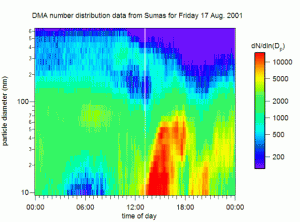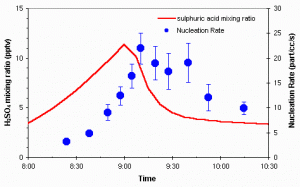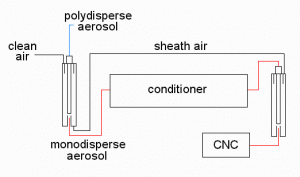|
In addition to laboratory experiments, my group is involved in field measurements. This work includes measurements of total particle number concentrations, particle size distributions, and the hygroscopic properties of atmospheric particles. We intend to use these data in order to better understand both the formation and growth of atmospheric particles and the physical properties of atmospheric particles. These methods make use of the differential mobility analyzer to size select particles. Recent field campaigns include a study in Egbert, Ontario focusing on particle nucleation and cloud droplet formation properties and a study of trans-boundary pollution in Southern Ontario. Principle Component Analysis of Atmospheric Particle Size Distributions The figure on the below shows one day's data measured with a DMA/CPC during the Pacific 2001 study at a site near Abbottsford, British Columbia. There are 30 size bins (logarithmically spaced from 9 nm to 640 nm) measured at 288 times (every 5 minutes); the color scale gives the number of particles per cubic centimeter of air for each of these points. The most obvious feature is the dramatic nucleation and growth event that begins at about noon with the formation of a large number (shown in red) of very small particles that rapidly grow to diameters of several 10's of nanometers. Measurements like these potentially provide a great deal of information on how particles behave in the atmosphere. But one of the challenges with using this data is that there is so much of it - a typical field study, lasting several weeks, will produce several hundred thousand data points. That is really too much for the human brain to process without some form of simplification. In order to do this Tak Chan, who completed his PhD in Chemistry in the Mozurkewich group, developed a method of applying principle component analysis to data sets of this type. Formation and Growth of Atmospheric Particles Measurements of particle size distributions as a function of time such as the one shown above, should allow us to determine the rate of gas-to-particle conversion, the rate of particle growth, and the rate of particle formation. But this sort of analysis has met with limited success. One difficulty is that the size distributions are also affected by a number of complicating factors, such as dilution, coagulation, and deposition. Also, the limitations of the instruments used to measure the particle size distributions means that there is a gap in the measurements as newly formed particles grow to a detectable size. Finally, noise in the data can cause numerical instabilities in extracting the desired quantities. A former graduate student in the Mozurkewich group, Bart Verheggen, developed a robust method for obtaining particle growth and nucleation rates from measured size distributions. By working with cumulative size distributions, we developed a numerically stable procedure for extracting the growth and nucleation rates. Bart is continuing to develop this method with the goal of creating a database of nucleation rates obtained from atmospheric observations. We hope to use such a database to get a better understanding of particle formation in the atmosphere. At present, much of our understanding is based on a highly uncertain theory of nucleation. An example of the results of analyzing a nucleation event is shown below. The solid line shows the H2SO4 mixing ratio (in parts per trillion by volume) calculated from a numerical model. Since the H2SO4 is formed from oxidation of SO2, measured SO2 concentrations are used as one input to the model. The points are particle formation rates obtained from the measured size distributions. We expect a high H2SO4 mixing ratio to lead to a high nucleation rate; the figure shows a reasonable agreement between these quantities. Some of the data to be used in the development of the analyses described above were obtained as part of CAC (Centre for Atmospheric Chemistry) field campaigns designed to get a better understanding of gas-to-particle conversion in several environments in southern Ontario. A preliminary study took place in Hamilton, Ontario during the summer of 1999. The major measurement effort took place in the Summer of 2000 in Hamilton and at Simcoe, a rural site in southern Ontario. These campaigns included measurements by a number of research groups of gas phase precursors and aerosol composition including speciated measurements of organic compounds, ions, and metals. My group measured particle size distributions and particle hygroscopic properties. We also participated in the Pacific 2001 study, a large, multi-site, multi-investigator campaign that inverstigated air quality issue in the lower Fraser Valley; our group made measurements at a site outside of Abbotsford, British Columbia. More recently, we participated in two field campaigns in the summer of 2007. A campaign in Egbert, Ontario focused on particle nucleation and growth and on the cloud droplet formation properties of particles. That campaign was organized by researchers from the University of Toronto and the Meteorological Service of Canada. The second campaign was the Border Air Quality Study; this was devoted to the impact of trans-boundary pollution and lake breezes on air quality in southwestern Ontario. It involved investigators from a variety of organizations. Hygroscopic Properties of Atmospheric Particles These measurements use a Differential Mobility Analyzer (DMA) to select atmospheric particles of a single size. The particle sizes are then modified by changing the relative humidity to change the amount of water in the particles. Then a second DMA is used to determine the size distribution of the modified particles. These methods were developed by Yayne Aklilu, who completed her PhD in Earth and Space Science in 2005. The method is currently being applied to smog chamber experiment by Naeem Lodhi, a Chemistry graduate student, and to field data by Kristina Zeromskiene, a post-doctoral fellow. These measurements have two goals. One is to try to correlate the hygroscopic properties of the particles with measurements of composition. The second is to determine the extent to which the particles are "internally mixed" (that is, all particles have the same mix of components and, therefore, the same thermal and hygroscopic properties) or "externally mixed" (that is, the aerosol consists of a mixture of particles with very different compositions and different thermal and hygroscopic properties). This provide clues to the history of the particles in the atmosphere.
|
Updated on December 14th, 2012.



